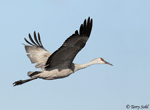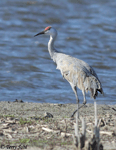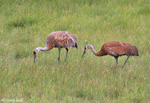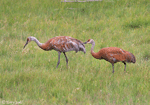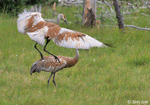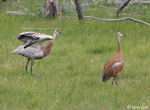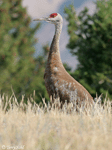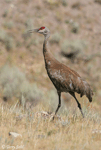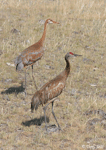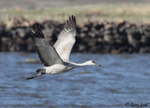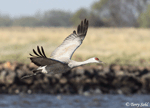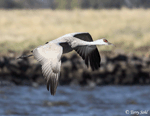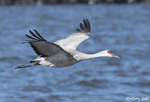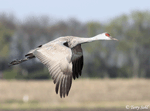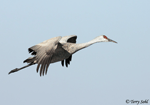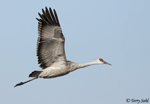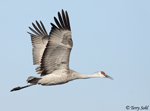| Length: 36 to 48 inches | Wingspan: 70 to 90 inches | Seasonality: Migrant |
| ID Keys: Gray body, red forehead area, white cheeks and upper throat, large size | ||
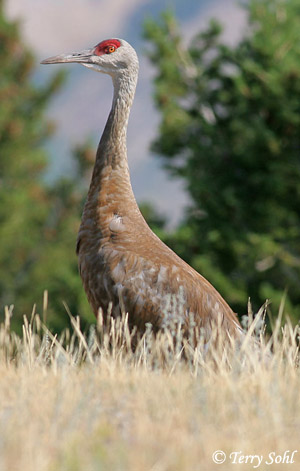 The most common crane in
the world, Sandhill Cranes are best known in this area for their yearly stopover
during migration at the Platte River in south-central Nebraska, where 90% of the
world's population can be found in the early spring. Different races of
Sandhill Cranes may exhibit a fairly large variation in size. The most
common of the migrating races are generally stable or increasing in population,
but non-migratory populations in Mississippi and Cuba are endangered.
The most common crane in
the world, Sandhill Cranes are best known in this area for their yearly stopover
during migration at the Platte River in south-central Nebraska, where 90% of the
world's population can be found in the early spring. Different races of
Sandhill Cranes may exhibit a fairly large variation in size. The most
common of the migrating races are generally stable or increasing in population,
but non-migratory populations in Mississippi and Cuba are endangered.
Habitat: Prefers to breed in or around a variety of marshy areas. During winter and migration, they can spend much of their time feeding on waste grain in agricultural fields.
Diet: Omnivorous, feeding on a wide variety of items including waste grain, seeds, roots and other plant material, frogs, various mollusks and crustaceans, small rodents, snakes, lizards, and large insects. The diet can vary tremendously between locations and at different seasons.
Behavior: Gregarious outside of breeding season, found in sometimes extremely large flocks. During breeding season, family groups are typically scattered and distinct.
Nesting: Non-breeder in South Dakota
Song: Sandhill Crane Song
Migration: Summers throughout much of Canada, Alaska, the Great Lakes region, and locally in the northwestern U.S. There also are breeding populations in Siberia. Winters in the extreme southern U.S. and points south.
Interactive eBird Map: Click here to access an interactive eBird map of Sandhill Crane sightings
Similar Species: Generally distinctive. The only other large crane normally found in South Dakota is the Whooping Crane in migration. The most similar would likely be the Common Crane, a Eurasian species that has sometimes strayed to North America, typically found within flocks of migrating Sandhill Cranes.
Conservation Status: Local (non-migratory) races in some locations (such as Mississippi) are endangered. Most populations are stable or increasing, however. The IUCN considers the Sandhill Crane to be a species of "Least Concern".
Further Information: 1) Patuxent Bird Identification InfoCenter, Sandhill Crane
3) Audubon Guide - Sandhill Crane
Photo Information: August 2007 -Yellowstone National Park, Wyoming - Terry Sohl
Additional Photos: Click on the image chips or text links below for additional, higher-resolution Sandhill Crane photos.
| Click on the map below for a higher-resolution view |
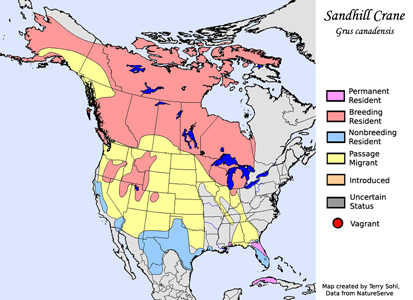 |
| South Dakota Status: Common migrant in the western and central part of the state, much less numerous in the east. |
Additional Sandhill Crane Photos
Click for a higher-resolution version of these photos
